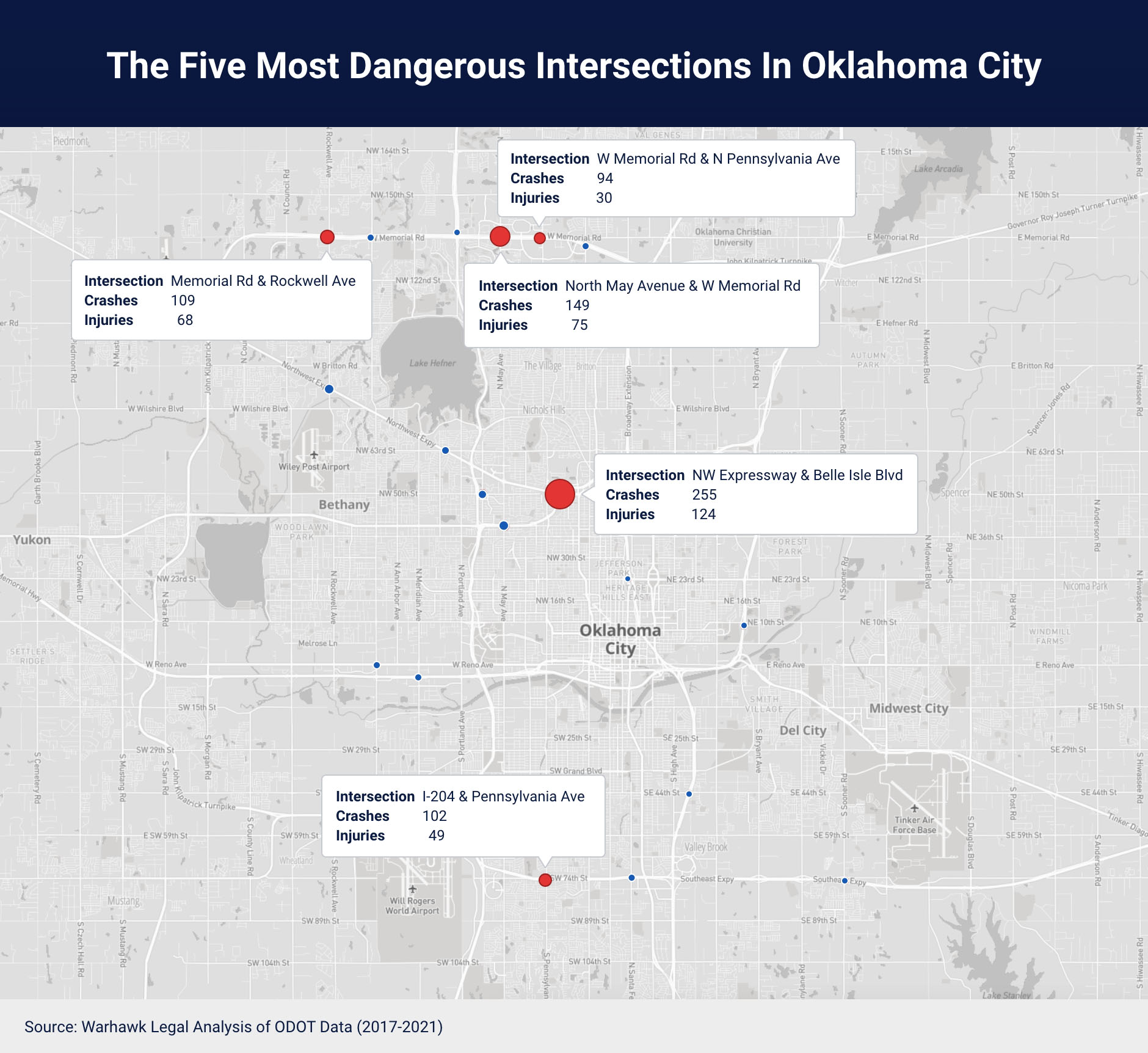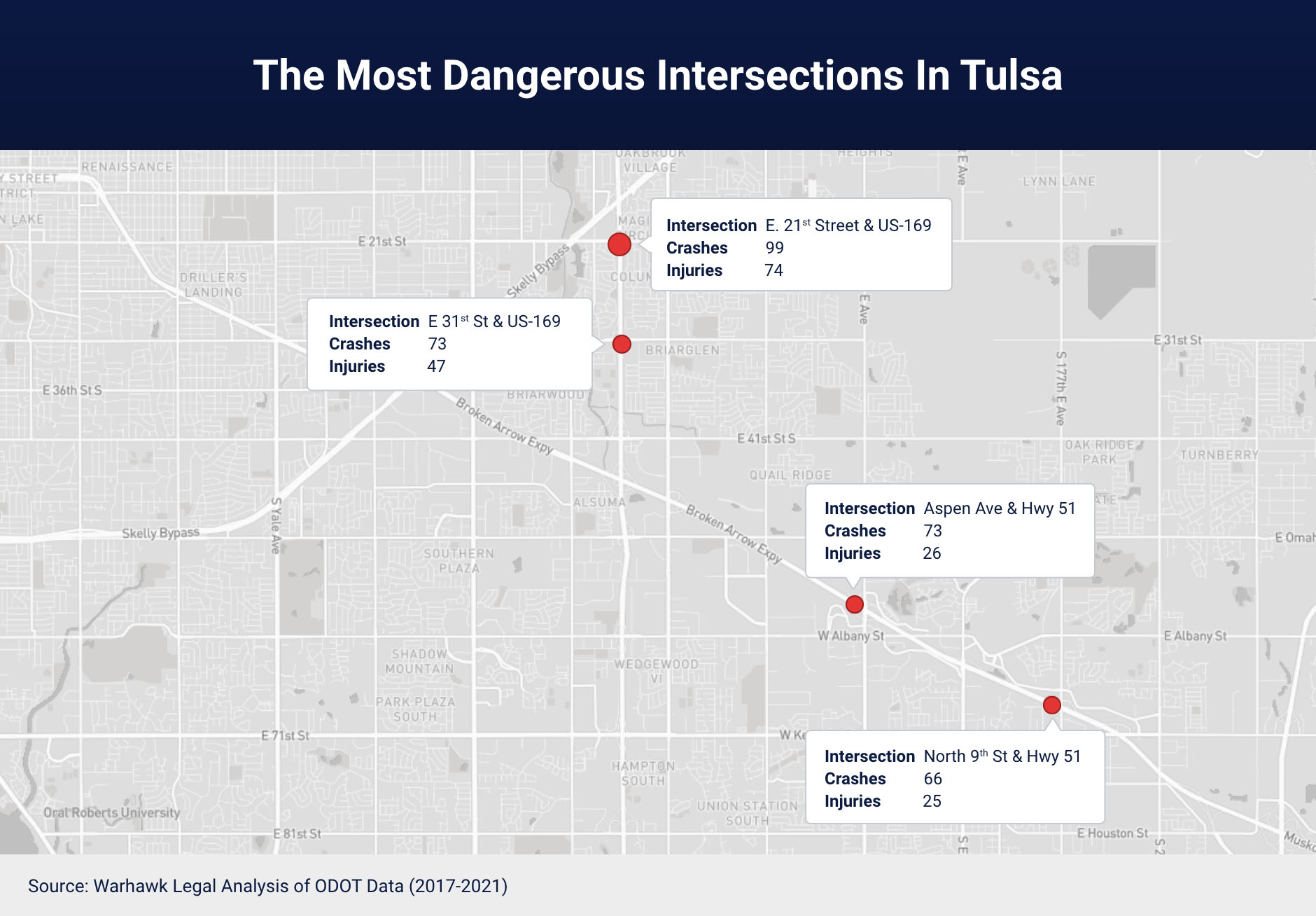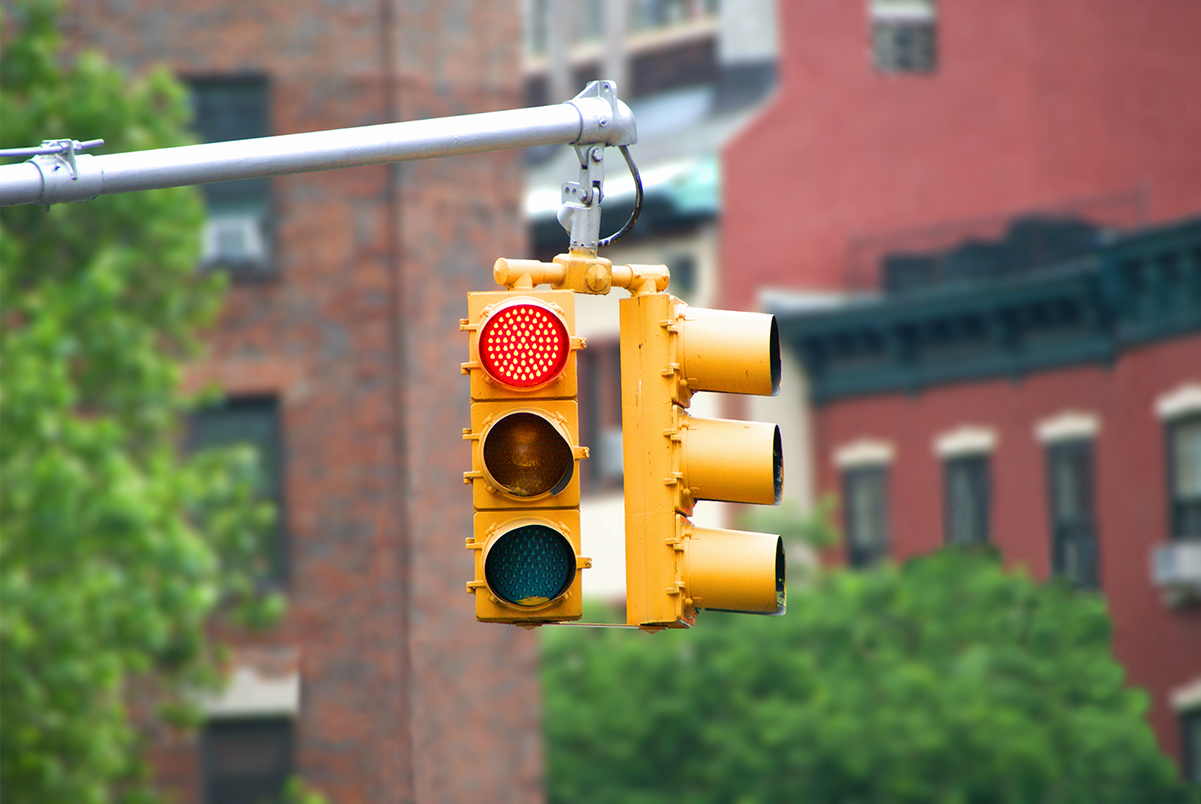Key Takeaways:
- Of the top 25 most accident-prone intersections in the state, 19 are located in Oklahoma City.
- The most accident-prone intersection in Oklahoma is Northwest Expressway and Belle Isle Boulevard, with 255 crashes over five years.
- Tulsa’s East 21st Street and US-169 has the largest share of crashes resulting in injuries, accounting for 44% of crashes.
- Oklahoma City experiences 30% of all intersection crashes in the state, followed by Tulsa at 14% and Broken Arrow at 3%.
- Tulsa County has recorded the most fatal crashes (95) of any county in Oklahoma over five years.
Driving comes with inherent risks, and certain areas of the road are more dangerous than others—intersections being among the most hazardous. These locations are especially prone to crashes as vehicles converge from multiple directions, creating a higher potential for collisions. With factors like distracted driving, reckless behavior, and other dangerous actions, crashes at intersections are all too common. In fact, each year, a quarter of all crashes in the U.S. occur at intersections, and each state has its own story to tell. Over the past five years, Oklahoma has seen 103,962 intersection-related crashes. In this article, we analyze these incidents to pinpoint the most crash-prone intersections in the state and uncover troubling patterns at the city and county levels.
Where Do Intersection Crashes Happen Most?
We begin by highlighting the top 25 intersections in Oklahoma with the highest number of crashes over a 5 year period, along with the number of crashes where at least one injury was reported, and the percentage of crashes involving injuries at each intersection.
Of the top 25 intersections in Oklahoma with the most incidents, 19 are located in Oklahoma City, including the one ranked first: Northwest Expressway and Belle Isle Boulevard. This intersection recorded 124 injuries over five years, with one-third of crashes resulting in injuries. Expressway intersections often feature complex traffic patterns that, when combined with higher speeds and impatient driving, lead to more accidents. Similarly, many other intersections on this list involve highways or serve as feeders to them. A notable example is Memorial Road and Rockwell Avenue (ranked third), which experiences traffic merging from the nearby John Kilpatrick Turnpike. This intersection experienced 68 injuries from crashes, representing 35% of its incidents.
Sometimes, however, the circumstances surrounding intersection crashes are less predictable. A recent wrong-way crash occurred at North Pennsylvania Avenue and West Memorial Road, the sixth most dangerous intersection on the list. Over five years, this location has seen 94 crashes and 30 injuries, with 22% of all incidents resulting in harm.
At East 21st Street and US-169, Tulsa houses the intersection with the largest share of crashes that resulted in injuries at 44%. Another Tulsa intersection on US-169 is East 31st St. & US-169, with a similarly large injury share at 42%. US-169, a major north-south highway, spans across much of Oklahoma and serves as a key corridor for both local traffic and long-distance travel.
The map below highlights the top 5 intersections in Oklahoma City with the highest number of crashes.

Next we zoom in on Tulsa, home to four of the top 25 crash-prone intersections.

A Look at Intersection Crashes Across Oklahoma Cities
Here’s a look at the top 50 Oklahoma cities ranked by intersection crashes from 2018 to 2022, with each city’s share of the state’s total crashes.
The top three cities with the most intersection crashes are Oklahoma City, Tulsa, and Broken Arrow. Oklahoma City stands out with a significant lead, accounting for nearly 30% of all intersection crashes in the state with 30,721 incidents. Tulsa follows with 14,414 crashes, making up 13.86% of the total. Broken Arrow, while much smaller in comparison, still ranks third with 3,457 crashes, representing 3.33% of the state’s total intersection crashes.
The top five cities for crashes in the state also happen to be the five most populous cities in the state, demonstrating that urban areas, with higher traffic volumes and more complex road designs, are more prone to crashes.
Exploring Intersection Crashes Across Oklahoma Counties
Having explored the intersection crash data at the city level, we now turn our attention to the top 50 counties in Oklahoma, examining their crash totals, crashes involving fatalities, and the share of intersection crash fatalities within each county.
The counties with the highest crash totals mirror some of the trends seen at the city level. Oklahoma County leads the state with 34,609 crashes, accounting for 32.48% of all crashes in the county. It’s followed closely by Tulsa County, which records 20,551 crashes, making up 32.84% of the county’s total. While these counties contribute a large share of crashes, they also have a relatively lower percentage of fatal crashes, with Oklahoma County reporting 88 fatal crashes (0.25%) and Tulsa County reporting 95 fatal crashes (0.46%).
Other counties like Muskogee and Woodward show higher shares of intersection crashes. Muskogee County, for instance, has the highest share of intersection crashes at 45.29%, 80% higher than the national figure, with Woodward County behind at 39.76%. Though these counties have fewer total crashes compared to Oklahoma and Tulsa, they still highlight areas with more concentrated intersection crash risks.
Additionally, counties like Blaine and Caddo show notable shares of fatal crashes in relation to their total crashes. Blaine, with 190 intersection crashes recorded over five years, has 3.78% of those resulting in at least one fatality. In comparison, Caddo, with 243 crashes reported, sees 14.57% of them being fatal.
Addressing Intersection Safety in Oklahoma
The data reveals clear patterns in Oklahoma’s intersection crash hotspots, with Oklahoma City and Tulsa standing out due to their high volume of accidents and associated injuries. These trends demonstrate critical areas where targeted safety improvements could have the greatest impact. Although efforts to reduce crashes across the state have been made, there’s still much work to be done. Addressing factors like distracted and impaired driving, speeding, and better infrastructure planning can make a significant difference. As Oklahoma continues to focus on improving safety at high-risk intersections, involving communities in the conversation and considering the needs of vulnerable road users will be key to further reducing accidents and saving lives.
Methodology
We analyzed five years of data (2018-2022) from the Oklahoma Highway Safety Office (OHSO) to identify intersections, roads, cities, and counties in Oklahoma with concerning intersection crash patterns.
Fair Use Statement
We hope readers find this article valuable and informative. Feel free to share our findings, but we kindly ask that you link back to this page to provide proper attribution.
